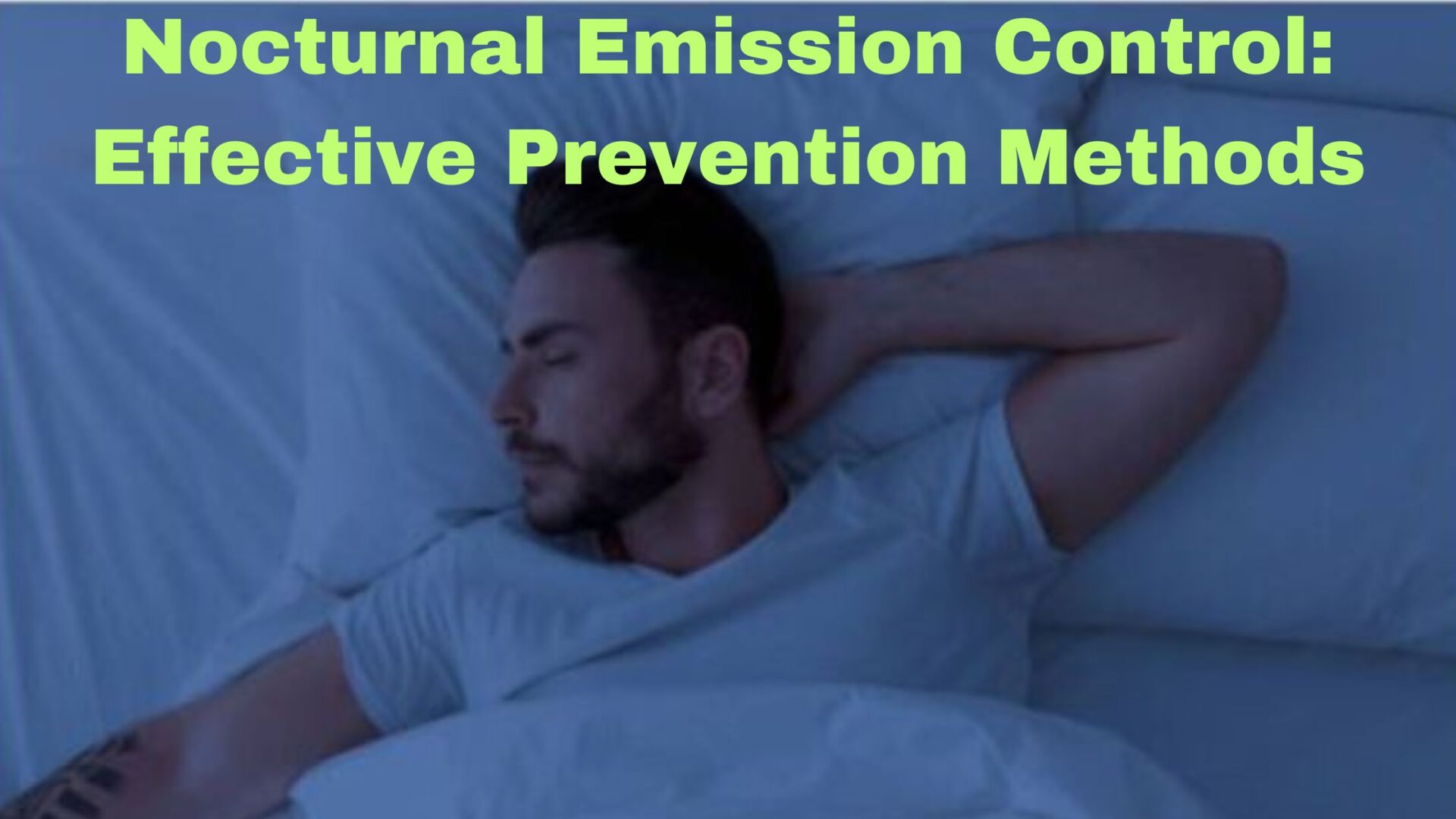Introduction:
Nocturnal Emission Control: Effective Prevention Methods

Nocturnal emissions, commonly known as “wet dreams,” are a natural and involuntary occurrence for many men. They happen during sleep when sexual dreams or thoughts trigger ejaculation. While this is a normal part of sexual development, some individuals may seek ways to reduce or control these occurrences. In this article, we will explore effective prevention methods to help those who wish to minimize or manage nocturnal emissions.
Understanding Nocturnal Emissions:
Before we delve into prevention methods, it’s essential to understand that nocturnal emissions are not harmful, and they do not signify any underlying health problems. In fact, they are a sign of a healthy reproductive system. However, for various reasons, some men may want to reduce their frequency, such as cultural, religious, or personal beliefs.
Effective Prevention Methods:
- Abstaining from Sexual Stimuli: One of the most straightforward ways to reduce the frequency of nocturnal emissions is to minimize exposure to sexual stimuli, both in real life and through various media. Avoiding explicit content and reducing sexual fantasies can help in this regard.
- Healthy Lifestyle Choices: Maintaining a healthy lifestyle is crucial for overall well-being, including reproductive health. Regular exercise, a balanced diet, and adequate sleep can help balance hormone levels and potentially reduce the likelihood of nocturnal emissions.
- Stress Management: High levels of stress and anxiety can lead to more frequent nocturnal emissions. Engaging in stress-reduction techniques, such as meditation, yoga, or deep breathing exercises, can help manage stress and decrease the occurrence of wet dreams.
- Kegel Exercises: Kegel exercises, which involve contracting and relaxing the pelvic floor muscles, can help improve control over ejaculation. This may result in fewer nocturnal emissions for some men.
- Avoiding Overstimulation Before Bed: It’s a good idea to avoid engaging in sexual activities, including self-stimulation, shortly before bedtime. This can help reduce the chances of nocturnal emissions occurring during the night.
- Sleeping Positions: Some people find that sleeping in certain positions can influence the occurrence of nocturnal emissions. Experimenting with different sleep positions may help you discover what works best for you.
- Herbal Remedies: Some herbal remedies and dietary supplements, like ashwagandha, saw palmetto, and fenugreek, have been suggested as potential aids in reducing the frequency of wet dreams. However, it’s essential to consult with a healthcare professional before trying any of these remedies.
Is it bad to have nocturnal emissions?
Nocturnal emissions, often referred to as “wet dreams,” are not inherently bad or harmful. In fact, they are a natural and normal part of male sexual development and function. Here are some key points to keep in mind about nocturnal emissions:
- Normal Part of Puberty: Wet dreams typically begin during puberty, often in the teenage years. They are a sign that a young man’s reproductive system is becoming active and functioning as it should.
- Healthy Function: Nocturnal emissions are a way for the body to release excess semen and maintain healthy sperm production. It’s a natural process to prevent the buildup of old sperm.
- Not a Sign of Illness: Nocturnal emissions do not indicate any underlying health problems or diseases. They are not linked to sexual dysfunction, infertility, or other medical conditions.
- Varies Among Individuals: The frequency of wet dreams can vary greatly among individuals. Some people may have them more often, while others may rarely or never experience them.
- Cultural and Personal Beliefs: For some individuals, cultural or personal beliefs may lead them to seek ways to reduce or control the frequency of nocturnal emissions. In such cases, prevention methods can be explored, as discussed in the previous article.
It’s essential to understand that experiencing nocturnal emissions is entirely normal and healthy. If you have concerns about their frequency or any other aspect of your sexual health, it’s a good idea to consult with a healthcare professional or a sexual health expert who can provide guidance and address your specific needs or concerns.
What is the biological reason for wet dreams?
Wet dreams, scientifically known as nocturnal emissions or sleep orgasms, occur due to a combination of physiological and hormonal factors. The biological reasons for wet dreams are as follows:
- Sexual Maturation: Wet dreams are most commonly experienced during adolescence, typically in teenage years. As a young man goes through puberty, his body undergoes significant changes in sexual development. This includes an increase in sex hormones like testosterone, which drive sexual desire and the development of the reproductive system.
- Semen Production: During puberty, the testes (testicles) begin to produce sperm and seminal fluid (semen) at a faster rate. This increased production results in the accumulation of semen in the seminal vesicles.
- Sexual Dreams and Arousal: During the rapid eye movement (REM) stage of sleep, which is when most dreaming occurs, the brain may generate sexual dreams or scenarios. These dreams can lead to sexual arousal, including the physiological response of an erection and the release of sexual tension.
- Ejaculatory Reflex: The body has a built-in mechanism to release excess semen and maintain a healthy sperm count. When a certain level of sexual tension is reached during a dream, the body may trigger the ejaculatory reflex. This leads to the rhythmic contractions of the pelvic muscles, followed by ejaculation and orgasm. Because the individual is asleep, this process is often not consciously controlled.
- Natural and Healthy Process: Wet dreams are a natural way for the body to release excess semen and prevent the buildup of older, less viable sperm. It is a part of the body’s reproductive system maintenance and is considered a normal and healthy process.
It’s important to note that wet dreams are not a sign of sexual dysfunction or a health problem. They are a common and expected part of sexual development and maturation. While they may be embarrassing or surprising to some individuals, understanding their biological basis can help demystify and normalize this natural occurrence.
How do I stop nightfall and wet dreams?
Nocturnal emissions, commonly known as nightfall or wet dreams, are a normal and healthy part of sexual development. However, if you’re looking to reduce their frequency or eliminate them, there are some strategies you can consider. It’s important to remember that while some people may be able to reduce the occurrence of wet dreams, complete elimination may not be possible for everyone. Here are some tips:

- Maintain a Healthy Lifestyle:
- Regular exercise can help balance hormone levels and reduce sexual tension.
- Follow a balanced diet with nutritious foods.
- Get enough sleep as irregular sleep patterns can sometimes trigger wet dreams.
- Reduce stress through relaxation techniques such as meditation, yoga, and deep breathing exercises.
- Limit Sexual Stimuli:
- Avoid explicit content in media and reduce sexual fantasies or daydreams, especially before bedtime.
- Kegel Exercises:
- Some individuals have reported improved control over ejaculation through regular Kegel exercises, which target the pelvic floor muscles.
- Avoid Overstimulation Before Bed:
- Engaging in sexual activities, including self-stimulation, shortly before bedtime can increase the likelihood of wet dreams. Try to avoid such activities close to bedtime.
- Sleep Positions:
- Some individuals have reported that changing their sleep positions can influence the occurrence of wet dreams. Experiment with different sleep positions to see if it makes a difference for you.
- Herbal Remedies and Dietary Supplements:
- Some herbal remedies and dietary supplements, like ashwagandha, saw palmetto, and fenugreek, have been suggested to potentially reduce the frequency of wet dreams. Consult with a healthcare professional before trying any of these remedies.
- Communication and Education:
- Open communication with a healthcare professional or a sexual health expert can help address any concerns and provide personalized guidance.
It’s important to understand that the effectiveness of these methods can vary from person to person. Additionally, while some people may be able to reduce the frequency of wet dreams, complete elimination may not be possible for everyone, as they are a normal part of sexual development.
Conclusion:
Nocturnal emissions are a natural and healthy part of male sexual development, but for those who wish to control or reduce their frequency, various prevention methods are available. It’s important to remember that what works for one person may not work for another. Therefore, it’s advisable to consult with a healthcare professional or a sexual health expert for personalized guidance and recommendations. Ultimately, open communication and a positive attitude towards one’s sexual health are essential in managing and understanding nocturnal emissions.
